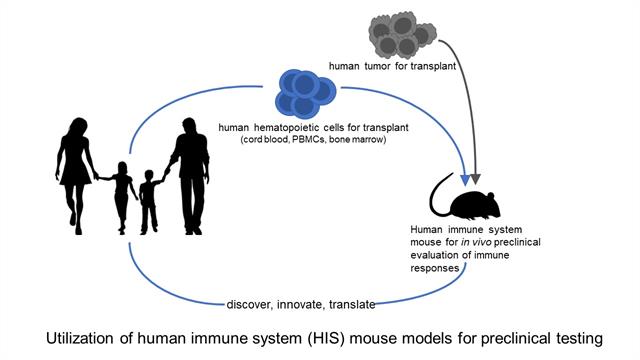Pre-clinical Human Immune System Mouse model (PHISM) Shared Resource
Welcome to the Pre-clinical Human Immune System Mouse model Shared Resource (PHISM) website!

The purpose of the Pre-clinical Human Immune System Mouse model Shared Resource (PHISM) is to provide a nexus for multiple aspects of translational immunology research. The PHISM core enables and promotes collaboration among investigators along the continuum of basic-translational-clinical research by establishing mechanisms that facilitate availability of human tissue for research and by generating and maintaining preclinical mouse models for the development and testing of candidate therapeutics.
Access to Human Immune System ("humanized") or "HIS-mice"
Novel immunotherapies must be tested with sophisticated preclinical models before they can be tried in humans. Ideally, these models should provide a platform where the human immune system can be exposed to experimental and therapeutic manipulations and the readout is meaningful and applicable to humans.
The PHISM will provide this key component with the production, distribution and/or analysis of Human Immune System (HIS) mice. HIS-mice are immunodeficient recipient mice that have been transplanted with a human immune system, or some of its components. Our basic model uses a BRGS (Balb/c-Rag2-/-IL2R γ
-/-SIRPαNOD) highly immunodeficient recipient lacking T,B (Rag2-/-) and NK(IL2Rγ-/-) cells as well as macrophage tolerance due to the human-compatible SIRPα gene. This immunodeficient mouse strain is well reconstituted with human immune cells, either directly from human peripheral blood cells (HIS-PBMC-BRGS) or from human hematopoietic CD34+ stem cells isolated from umbilical cord blood (HIS-CB-BRGS). The later model has the benefit of multi-lineage reconstitution of a human immune system with B, T and myeloid cells whereas the former models primarily activated human T cells that induce graft versus host disease in the recipient. Importantly, the HIS-mice can be engrafted with human tumors, either cell-line or patient-derived. Thus, they become an ideal tool for testing the effects of novel immunotherapies—such as immune checkpoint inhibitors—on human immune responses.
While more often used in the immune-oncology arena, Human Immune System mice can also be utilized to understand basic mechanisms of the human immune system and to study genetic, biological, and pharmacological therapies to autoimmune and inflammatory responses. The laboratory directed by Dr. Roberta Pelanda has spent the last 10 years developing and improving Human Immune System mice for the study of B cells in the context of autoimmunity. In the last 5 years, the PHISM laboratory has also been involved in using Human Immune System mice to study the effects of drugs on the immune response to tumors.
Additional Human Immune System mouse models are under development that will expand current capabilities. We are validating models with improved human myeloid cells after engraftment for human tumor studies. These models include the NBSGW (NOD.CgKitW41J Tyr + Prkdcscid Il2rgtm1Wjl/ThomJ) or NSGS
Access to experimental design support and research-related services:
The PHISM team offers expert experimental design support on projects, assistance in a variety of research needs within projects (e.g. antibody panel design for flow cytometric analyses, isolation and processing of cells from HIS-mice, cell staining, sample runs on the flow cytometer, analysis of flow data) and integration with the HIMSR for additional analyses (e.g. Vectra, CyTOF, etc.).
We look forward to hearing from you!
Contact
Julie Lang, PhD
Co-Director, Pre-clinical Human Immune System Mouse Core
303-724-4684
[email protected]